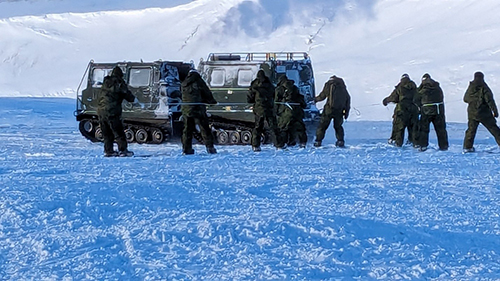Arctic Allies: Defence Research & Development Canada and the Joint Arctic Experiment in Op NANOOK
October 07, 2024 - Defence Stories
The Joint Arctic Experiment (JAE) 24 aims to enhance Arctic capabilities and explore the effective use of emerging systems for surveillance, search and rescue, sustainment, mobility, energy efficiency, and shelter systems, while also prioritizing the safety of Canadian Armed Forces (CAF) personnel through human factors analysis. Coordinated by the Canadian Joint Warfare Centre (CJWC) with support from the Strategic Experimentation Account (SEA) under Chief Force Development (CFD), JAE plays a crucial role in facilitating research, experiments, and trials by Defence Research & Development Canada (DRDC) in the Arctic. The primary venue for JAE is the Op NANOOK series of operations led by Joint Task Force North (JTFN).
Op NANOOK-NUNALIVUT 24 took place in Resolute Bay, Nunavut, in February 2024. Its objective was to showcase the CAF's ability to project and sustain forces in the high Arctic while fostering international partnerships through multinational participation.
Op NANOOK-NUNAKPUT 24 occurred in Cambridge Bay, Nunavut, in August 2024. The focus was on enhancing CAF joint capabilities in Arctic surveillance and mobility along Canada’s Northwest Passage.
The Joint Arctic Experiment (JAE) has fostered relationships with Other Government Departments and Allies to develop an integrated capability development plan. Key findings emerged from collaborations with various research centers:
- Electro-Optical Satellites: The DRDC Valcartier Research Centre (VRC) conducted research and development activities aimed at enhancing Arctic surveillance capabilities and improving the tasking, collection, processing, exploitation, and dissemination (TCPED) cycle performance using commercial electro-optical (EO) satellite imagery.
- Surveillance Using Small Commercial Satellites: The Microsatellite Military Utility Project Arrangement (MSMU PA) provided valuable data through trials based on collaborative efforts between DRDC VRC and the Ottawa Research Centre (ORC).
- Detecting the Risk of Cold Weather Injuries (CWIs): The Canadian Forces Health Services and Environmental L1s sought effective methods for the prevention, diagnosis, and treatment of cold-related injuries. The DRDC Toronto Research Centre (TRC) is collaborating with the U.S. Army Research Institute of Environmental Medicine (USARIEM) to develop an OMICS-based biomarker system prototype for assessing environmental injury risks. The FY 23-24 study contributed to understanding susceptibility to CWIs among women and various ethnic groups.
- Integrated Energy and Shelter Solutions: The Atlantic Research Centre (ARC) has been working on this project since 2018 as part of JAE. Efforts are ongoing to eliminate open flames and create cleaner, safer heating and shelter sustainment systems for Arctic and cold weather deployments.
Written by Christian Gagnon (JAE Deputy Project Manager)

Caption
Arctic Response Group soldiers during cold weather training at the Crystal City Arctic training facility near Resolute Bay, participating in Op NANOOK-NUNAVUT in February 2024. (Photo by Christian Gagnon)

Caption
A Chinook CH-47 working alongside the Canadian Coast Guard ship Louis St-Laurent during Op NANOOK-NUNAKPUT in August 2024. (Photo by Christian Gagnon)